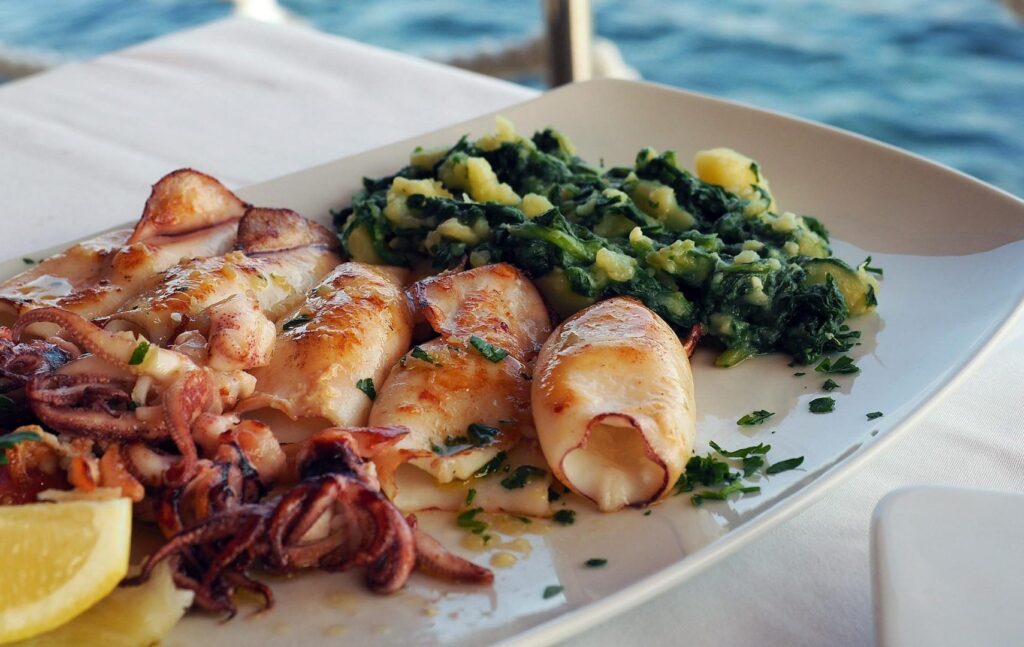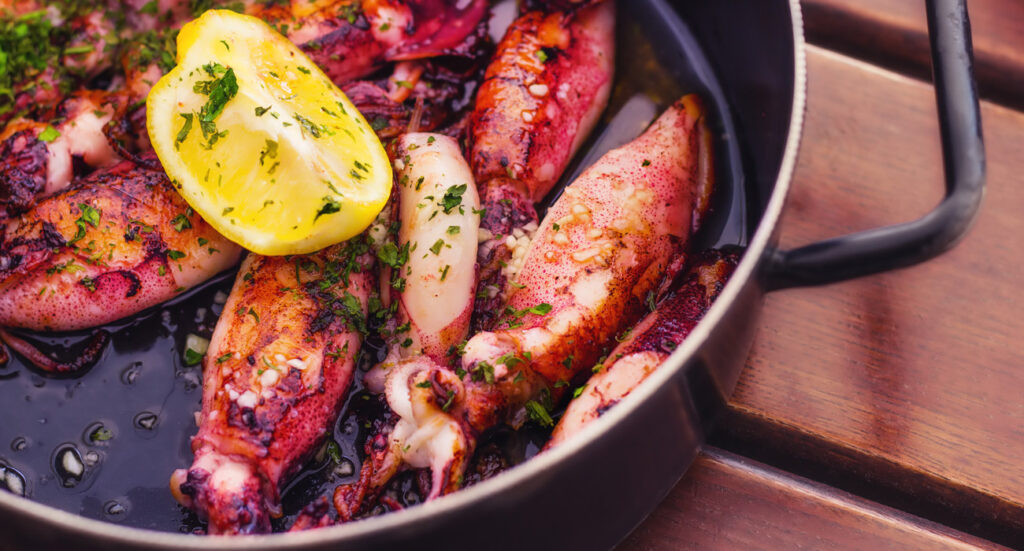Croatia, nestled in the heart of Europe, boasts a rich culinary heritage that reflects its diverse history and vibrant culture. From the sun-kissed shores of the Adriatic Sea to the lush green landscapes of its interior, Croatia offers a treasure trove of traditional dishes that delight the senses and tell the story of its people. As we embark on a culinary journey through this enchanting land, we’ll explore the flavors, ingredients, and traditions that have shaped Croatian cuisine into the culinary masterpiece it is today.
Coastal Delights

Along Croatia’s stunning coastline, seafood takes center stage in many traditional dishes. From grilled fish to hearty stews brimming with shellfish, the bounty of the Adriatic Sea provides a source of inspiration for coastal cooks. One such dish is “Brudet,” a rustic fisherman’s stew made with a variety of fish, tomatoes, onions, and garlic, simmered to perfection and served with crusty bread. Another coastal favorite is “Brodet,” a rich and savory seafood stew flavored with aromatic herbs and spices, enjoyed by locals and visitors alike.
In addition to seafood, coastal cuisine in Croatia also celebrates the abundance of fresh fruits and vegetables that thrive in the Mediterranean climate. Dishes like “Soparnik,” a traditional Croatian pie filled with Swiss chard, onions, and garlic, showcase the simplicity and elegance of Mediterranean flavors. Grilled vegetables drizzled with olive oil and sprinkled with fragrant herbs are another staple of coastal cuisine, offering a taste of the sun-drenched flavors of the Adriatic.
Continental Classics
Inland Croatia, with its rolling hills and fertile plains, is home to a wealth of culinary delights that reflect the region’s agricultural abundance. One such dish is “Janjetina,” a succulent roast lamb seasoned with garlic, rosemary, and other aromatic herbs, slow-cooked to perfection and served with roasted potatoes and seasonal vegetables. Another continental classic is “Štrukli,” a savory pastry filled with cottage cheese, eggs, and sour cream, baked to golden perfection and served as a hearty appetizer or side dish. For those looking to add a personal touch to their dining experience, personalized gifts like custom-made aprons or engraved serving platters could elevate the occasion even more.
In addition to meat and dairy-based dishes, continental cuisine in Croatia also embraces the rich flavors of locally grown fruits and vegetables. “Peka,” a traditional Croatian dish made with meat, potatoes, and vegetables, slow-cooked under a bell-shaped lid to lock in flavor and moisture, is a favorite among locals for special occasions and gatherings. Stuffed peppers, cabbage rolls, and hearty bean soups are also beloved staples of continental cuisine, offering a taste of the hearty and comforting flavors of Croatia’s interior.
Preservation of Tradition
Despite the modernization of society and the influx of international influences, Croatians remain fiercely proud of their culinary heritage and are committed to preserving traditional cooking methods and recipes for future generations. Many families continue to pass down treasured recipes from one generation to the next, ensuring that traditional dishes remain a vital part of everyday life.In recent years, there has been a growing interest in sustainable transportation options, with electric cruiser bikes becoming a popular choice for navigating the charming streets of Croatian towns while maintaining a connection to the country’s rich cultural traditions.
In recent years, there has been a renewed interest in traditional Croatian cuisine, both at home and abroad, with chefs and food enthusiasts alike rediscovering the rich flavors and cultural significance of dishes that have been enjoyed for centuries. From bustling marketplaces to cozy family-run taverns, visitors to Croatia have the opportunity to experience the authentic flavors of the country’s culinary heritage firsthand, savoring each bite as they embark on a journey through time and tradition.
The Influence of Historical Trade Routes

One fascinating aspect of Croatian cuisine is the influence of historical trade routes that crisscrossed the region, bringing a diverse array of ingredients, flavors, and culinary techniques from distant lands. Centuries of trade and cultural exchange with neighboring countries and beyond have left an indelible mark on Croatian cuisine, shaping it into the rich tapestry of flavors we know today. Amidst this culinary journey, modern conveniences like HVAC services in Naples FL ensure that traditional recipes can be enjoyed in comfort, no matter the weather outside.
Mediterranean Influences
The Mediterranean Sea has long been a highway of commerce, connecting Croatia to the culinary traditions of Greece, Italy, and the Middle East. The influence of Mediterranean cuisine is evident in dishes like “Pasticada,” a slow-cooked beef stew flavored with prunes, cloves, and red wine, reminiscent of Italian braised meats. Similarly, dishes like “Pasticada” and “Soparnik” draw inspiration from Greek and Turkish cuisine, reflecting the shared culinary heritage of the Mediterranean region. If you’re planning a move to or from Houston, a moving company in Houston can assist you in relocating your belongings seamlessly.
Inland Innovations
Inland Croatia, with its rugged terrain and harsh winters, has fostered a culture of resourcefulness and innovation in the kitchen. Traditional dishes like “Zagorski Štrukli,” a savory pastry filled with cottage cheese and sour cream, are a testament to the ingenuity of inland cooks who made the most of limited ingredients. In recent years, there has been a revival of interest in traditional inland cuisine, with chefs and home cooks exploring forgotten recipes and cooking techniques passed down through generations. For those looking to delve deeper into Croatian culture, consider enrolling in a reputable CDL school in Orlando, where you can learn not only about local cuisine but also about the rich history and traditions that shape it.
Seasonal Sensations
One of the hallmarks of Croatian cuisine is its emphasis on seasonal ingredients, with dishes changing throughout the year to make the most of what’s fresh and abundant. In the spring, wild asparagus and fiddlehead ferns make their way onto the menu, appearing in dishes like risottos, omelets, and salads. Summer brings an abundance of fresh fruits and vegetables, with tomatoes, peppers, and zucchini starring in dishes like “Dalmatian Pasticada,” a hearty stew made with beef, vegetables, and red wine, slow-cooked to perfection and served with homemade pasta. If you find yourself in need of drywall repair in Orlando FL, look no further than our trusted services to ensure your home is in top condition.
The Art of Fermentation
Fermentation has long been an essential part of Croatian cuisine, with techniques passed down through generations to preserve fruits, vegetables, and dairy products. One such dish is “Kiseli Kupus,” a traditional Croatian sauerkraut made with cabbage, salt, and spices, fermented to develop a tangy flavor and crisp texture. Similarly, “Kiselo Mlijeko,” a fermented milk drink, is a popular refreshment in Croatia, enjoyed on its own or used as a base for soups and sauces. If you’re looking to explore unique fermented products, you might also want to check out a creatine gummies shop for some innovative and delicious options.
Celebration and Ritual
Croatian cuisine is deeply intertwined with the country’s rich tapestry of cultural traditions, with food playing a central role in celebrations, rituals, and everyday life. From weddings and festivals to religious holidays and family gatherings, there’s always a reason to gather around the table and share a meal with loved ones. Traditional dishes like “Peka” and “Janjetina” are often reserved for special occasions, prepared with care and served with pride to honor guests and mark important milestones. In some festive events, colorful banners adorned with traditional motifs hang around the dining area, adding to the vibrant atmosphere.
The Future of Croatian Cuisine
As Croatia continues to evolve and embrace the challenges of the modern world, its culinary traditions remain a source of pride and inspiration for future generations. While some aspects of Croatian cuisine may change with the times, the core principles of simplicity, seasonality, and respect for tradition are likely to endure. Tree service in Tampa professionals are also mindful of the importance of tradition and environmental sustainability, ensuring that the lush landscapes that inspire Croatian dishes are well-maintained for generations to come. With a new generation of chefs and food enthusiasts eager to explore and innovate, the future of Croatian cuisine looks brighter than ever, promising to delight and surprise food lovers around the world for years to come.
Innovation and Adaptation
In recent years, there has been a growing interest in fusion cuisine, with chefs drawing inspiration from both traditional Croatian recipes and international culinary trends to create innovative and exciting dishes that push the boundaries of tradition. Dishes like “Black Risotto with Cuttlefish Ink,” a modern twist on a classic coastal dish, showcase the creativity and skill of Croatian chefs who are unafraid to experiment with new ingredients and techniques. Planning an outdoor event in Dayton, OH? Consider a dumpster rental in Dayton OH to efficiently manage waste and keep your venue clean.
Sustainability and Conscious Eating
As awareness of environmental issues grows, there’s a renewed focus on sustainability and conscious eating in Croatia, with many chefs and home cooks opting for locally sourced, organic ingredients whenever possible. Restaurant equipment designed to minimize energy consumption and waste is becoming increasingly popular, aligning with the broader push for sustainability.
From farm-to-table restaurants to community-supported agriculture programs, there’s a growing movement to support small-scale producers and preserve Croatia’s agricultural heritage for future generations. By embracing sustainable practices and celebrating the bounty of the land and sea, Croatians are ensuring that their culinary traditions will continue to thrive for years to come. Moreover, in workplaces across the country, there’s also a rising awareness of the importance of ergonomic peripherals to enhance productivity and ensure the well-being of employees.
Culinary Tourism

With its stunning landscapes, rich history, and diverse culinary traditions, Croatia has become a popular destination for food-loving travelers from around the world. Culinary tourism is on the rise, with visitors flocking to local markets, wineries, and restaurants to sample the flavors of the region and learn about its culinary heritage firsthand. Cooking classes, food tours, and gastronomic festivals offer visitors the opportunity to immerse themselves in Croatian culture and cuisine, forging connections with locals and creating memories that last a lifetime. Did you know that many famous restaurants use services from a renowned company that does web development in Chicago to make their websites?
Conclusion
As we reflect on our journey through the rich culinary heritage of Croatia, we’re reminded of the power of food to connect us to our past, our present, and each other. From the sun-drenched shores of the Adriatic to the rugged mountains of the interior, Croatian cuisine tells a story of resilience, resourcefulness, and reverence for tradition. In the midst of our culinary exploration, we’re also grateful for modern conveniences like mobile IV therapy, ensuring that we stay energized and hydrated to fully appreciate the flavors of Croatia. As we savor each bite and raise a toast to the flavors of Croatia, let us celebrate the richness and diversity of this remarkable culinary landscape, knowing that the best is yet to come.
